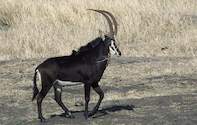
The botanically rich, high-rainfall mountainveld of the south-west provides habitat niches for some of Kruger's rarest antelope. This is the only part of Kruger Park where the the grey rhebok is found.
The south-west is the most mountainous part of Kruger and gets more rainfall than anywhere else in the Park. The granite foothills can be divided into two main habitats - the Malelane mountain veld in the south around Berg-en-Dal and the Pretoriuskop sourveld to the west around Numbi and Pretoriuskop.
Game viewing routes in South-west Kruger Park
At Malelane Gate
Malelane Skukuza via Afsaal
Malelane Skukuza via Biyamiti
Malelane to Berg-en-Dal
Malelane to Crocodile Bridge
Matjulu Loop
Numbi Gate
Numbi Gate to Skukuza
Pretoriuskop Area
Pretoriuskop to Malelane
See Kruger Park South West Self-drive Map
- Malelane mountain veld around Berg-en-Dal
- Pretoriuskop sourveld in the Numbi Pretoriuskop areas
- Sweetveld grazing from Afsaal along Voortrekker Road to Phabeni
- Mixed bushwillow and acacia woodlands between Jock's and Skukuza
Kruger's Rarer Antelope

The botanically rich, high-rainfall mountainveld of the south-west provides habitat niches for some of Kruger's rarest antelope. This is the only part of Kruger where the the grey rhebok is found.
Other uncommon sightings here include:
Eland: First recorded around Shabeni Hill in 1883 by the transport rider JG Basson
Sable: mentioned in the following anecdote; and Lichtenstein's hartebeest: Successfully reintroduced into Kruger from Malawi after local populations became extinct.
Other rare antelope in the south-west include red duiker, roan antelope and mountain reedbuck.
The Deadly Horns of the Sable
The first tourist to be hurt by an animal in Kruger was a man gored by a sable antelope in the early 1930s. The tourist apparently got out of his car near Pretoriuskop to take a photograph of a sable behind a tree. When he was about six metres from the object of his photographic intentions, it suddenly charged at him, impaling his thigh with one of its metre-long horns.
The snorting bull made several attempts to slash at the man with its horns as he lay wriggling around, bleeding in the dust. The tourist's life was saved by his screaming wife who leapt from the car and drove the animal off with sticks and stones. It was later ascertained that the sable bull that attacked the man had been driven mad by injuries inflicted during a fight with another sable male. Sable can be extremely aggressive, particularly when challenging other males or predators.
Even lions treat a sable with caution and respect. There have been several reports from Kruger over the years of lion being killed by sable. Mhalamhala, as the sable is known in Shangaan, has a fine repertoire of horned aggression displays. These include symbolic butting - a form of vigorous head nodding - head tossing, horning the ground and sideways slashing.

